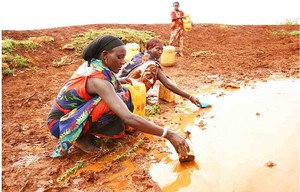Climate change impacts on water resources
Climate change leading to increased surface temperatures, melting of snow and glaciers, rise in sea level and an increase in extreme weather events such as droughts and floods, can significantly affect water resources. As you learned in Study Session 10, global warming increases the evaporation of water into the atmosphere and changes the patterns of major airstreams and ocean currents such as El Niño and La Niña. This in turn alters the distribution of precipitation, so some regions experience greater rainfall and flooding while others become more prone to droughts.
More frequent and longer periods of drought reduce the amount of run-off into rivers, streams and lakes; also the water table drops, so there is less groundwater to supply springs and shallow wells. During droughts, rural people – particularly women and children – may have to walk for up to six hours to collect water from unprotected water sources such as ponds (Figure 11.6). In drought-stricken rural areas, a higher priority is given to collection of water than to other activities, which can cause children to drop out of school because their labour is needed for water collection. In urban areas, poor people may be forced to use unclean water or to buy water from vendors at high prices. The extra money they spend on buying water could have been used for other purposes such as food, fuel and health care.

Figure 11.6 Borena women in Southern Ethiopia collecting water from a pond during a drought.